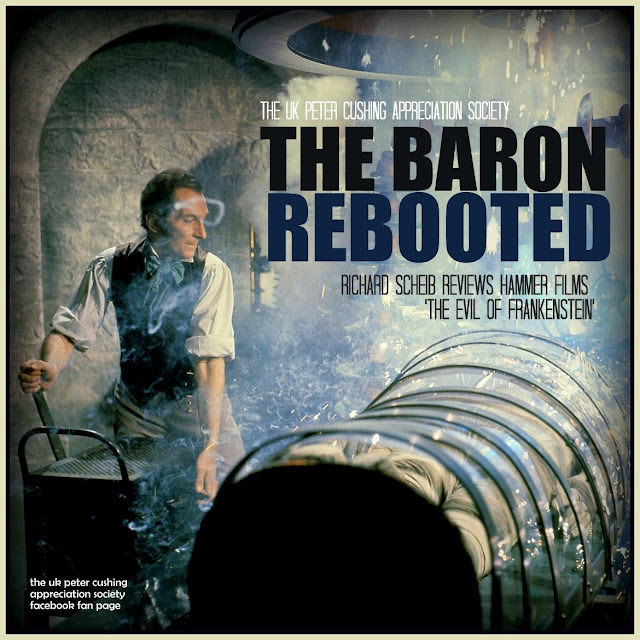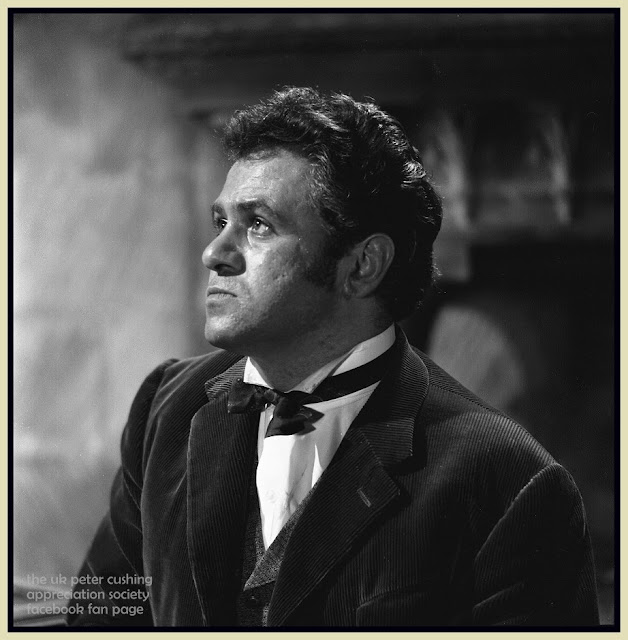Intrepid adventurers Major Holly (Peter Cushing), Leo (John
Richardson) and Job (Bernard Cribbins) are lead to the forbidden city,
while is ruled over by the beautiful and eternal Ayesha (Ursula
Andress)....
She: A History of Adventure was published in serial form between
late 1886 and early 1887. It was written by the prolific fantasy and
adventure novelist H. Rider Haggard and, along with his Alan Quartermain
adventures, it remains his most popular and oft-adapted book. It has
the distinction of influencing one of the earliest motion pictures,
Georges Melies' La Colonne de feu (The Pillar of Fire), which was made
in 1899. Subsequent adaptations cropped up in 1911, 1916, and 1917 -
and
in 1925, Haggard himself worked on an adaptation which starred silent
film star Betty Blythe in the title role. The most lavish version
emerged in 1935, courtesy of producer Merian C. Cooper.


Cooper had already unleashed King Kong (1933) on a thrill-hungry
depression-era audience, and he spared no expense in mounting this
particular adaptation. Helen Gahagan made for an appropriately
glamorous Ayesha, with stolid Randolph Scott providing beefcake as Leo.
Future big screen Dr. Watson Nigel Bruce was cast as Major Holly in
this version, which was co-directed by sometimes-character-actor Irving
Pichel, whom horror buffs will remember as the creepy Sandor in
Universal's Dracula's Daughter (1936). The story would then go on
something of a moratorium for a period of time, until Hammer Films
unleashed their own version in 1964. After that, the story would be
overhauled as a trashy, post apocalyptic piece starring Sandhal
Bergman in 1982. The most recent film version came in 2001, as a
direct to video release.


Inevitably, it is the Hammer version with which we concern
ourselves here. She was one of producer Michael Carreras' pet projects
and offered a fine example of his vision for the company. Carreras was
never overly enamored of the gothic horror genre, and it was he who
tried to push Hammer towards making David Lean-style spectaculars. The
problem was, Hammer simply didn't have access to Lean's resources. As
such, his attempts at making bigger, more ambitious films tended to
result in pictures which, paradoxically, looked a bit cheaper than the
smaller scale gothic fare for which the studio was best known. In
short, a story such a She, with its widescreen vistas and elaborate
settings, represented a case of Hammer's reach exceeding its
grasp.

The film is problematic on many levels. First off, Robert Day was perhaps not the
ideal director for such a project. Day
had directed Boris Karloff's two best 1950s vehicles - The Haunted Strangler
(1957) and Corridors of Blood (1958) - and he also had ample experience
directing for the small screen. She was
probably the biggest project of his career, and while he did the best job he
could under the circumstances, he fails to capture the story's magic and sense
of exotica. Hammer's ace production
designer, Bernard Robinson, was allowed to sit this one out for some reason -
and in his place, the capable Robert Jones (who also worked as art director on
Roger Corman's masterpiece Masque of the Red Death, 1964, before going on to
design Hammer's Dr. Jekyll and Sister Hyde, 1971) does a professional if
uninspired job. The sets look solid
enough, but they lack size and dimension.
For this reason, the production had to rely on a lot of matte work by
the great Les Bowie - and while Bowie could sometimes create minor miracles,
his matte work here is ill served by the film - it looks exactly like what it
is: paintings.

There's
also the casting to consider. Ursula
Andress was a hot ticket commodity based on her iconic appearance in the first
of EON's James Bond adventures, Dr. No (1962), but the Swedish-born actress was
still not comfortable in English and needed to be dubbed. She was also, quite simply, not the most
expressive of actresses. She looks
absolutely ravishing and fulfills the character's irresistible physical
presence well enough, but she is unable to tap into the character's deeper nuances,
resulting in a performance that is pure surface gloss. John Richardson (Mario Bava's Black Sunday,
1960) was similarly wooden and superficial - his good looks ensured him a
number of acting gigs (and rumor has it that he was at one point considered to
play James Bond), but his performances were always flat and uninvolving - and
despite being a native English speaker, he was regularly dubbed in his film
roles, including this one.


The
fact that these two pretty but vapid performers inhabit the center of what is
supposed to be a passionate love story creates a vacuum from which the film
simply cannot recover. On the plus side,
Hammer saw fit to enlist their top stars, Peter Cushing and Christopher Lee, to
play juicy supporting roles.



Cushing is
a joy as the adventure-hungry Major Holly, and the scene wherein he explains
the complex emotions inherent in love has a heartbreaking ring of truth to it -
it was reportedly a speech the actor wrote himself, and given how truthful it
is in a script which is otherwise efficient at best, one may well believe it. Lee is required to wear a succession of
garish and silly looking head gear as the stoic Billali, who helps to protect
Ayesha while secretly plotting against her, but he gives a strong
performance. There's a marvelous scene
between him and Cushing wherein Lee quietly but powerfully asserts himself that
makes a viewing of this film almost mandatory for fans of these two marvelous
actors. Bernard Cribbins (Hitchcock's
Frenzy, 1972) is effective as Cushing's comic sidekick/servant, while the
wonderful Andre Morell (Hammer's Plague of the Zombies, 1966) is wasted in a
nothing role - and to add insult to injury, the powers that be at Hammer
clearly decided that his cultured voice wasn't exotic enough for the character
he plays, so he was ultimately dubbed by another familiar Hammer veteran,
George Pastell. One wonders why they
didn't simply cast Pastell in the first place.

The film also
benefits from an achingly beautiful score by James Bernard. Bernard
loved scoring Hammer's blood and thunder horrors, but this gentle
natured composer always had a yen to score a great love story - and She,
for all its shortcomings, finally gave him that chance. His central
theme is one of the most beautiful and melodic of his career, while the
various adventure and action oriented pieces are appropriately rousing.
Cinematographer Harry Waxman (The Wicker Man, 1973) provides some slick
cinematography which helps to compensate for some of the film's less
impressive production attributes.
Ultimately, one doesn't wish to be too hard on She. It's not a
bad film, and it certainly looks very fine when compared to Hammer's
pointless (and quite inept) sequel The Vengeance of She (1967 - with
Richardson and Morell being the only cast members to return; Morell got
to keep his voice in
that one, at least), but it doesn't quite capture the flavor and
mystique of its titular character.
Images: Marcus Brooks.





































